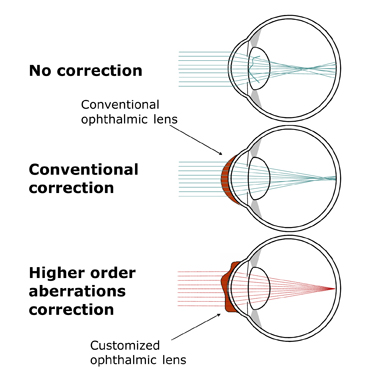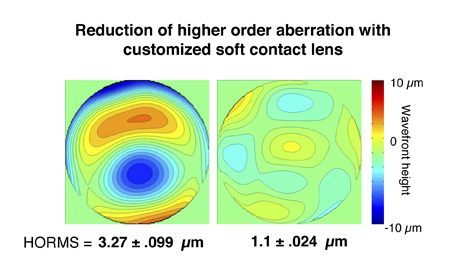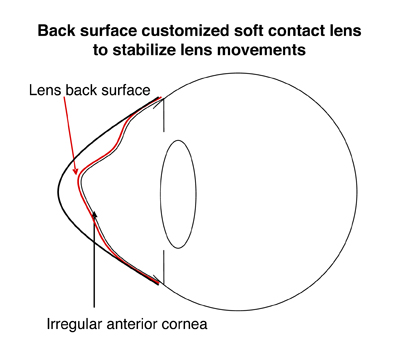
Advanced Physiological Optics Laboratory
Yoon Lab

As illustrated in figure below, the ability to correct the eye's higher order aberration in addition to defocus and astigmatism can provide substantially improved visual performance especially in eyes with abnormal corneal conditions. There have been optical and surgical methods that can correct the higher order aberration. They include adaptive optics, laser refractive surgery and customized ophthalmic lenses. Customized ophthalmic lenses are considered as one of the most practical, non-invasive correction option to correct the aberration resulting in vision improvement. These lenses have an irregular surface profile designed to produce an opposite wavefront to what the eye has so that the plane wavefront can be achieved when wearing these lenses. We have been developing customized spectacles (phase plate), customized soft contact lenses and customized scleral lenses.

Previous research in Yoon lab (Yoon et al., 2004) demonstrated visual performance improvement with the phase plate. Wavefront aberrations of subjects' eye were measured with a Shack-Hartmann wavefront sensor and used to precisely fabricate the phase plates using a lathe machine. Our wavefront measurements in normal eyes showed that the phase plate reduced the higher order root mean square (HORMS) wavefront error from 0.39 ± 0.09 to 0.15 ± 0.02 µm (mean ± standard deviation from three eyes) for a 6-mm pupil. Additionally improved visual acuity was also observed with the phase plates comparing with conventional spectacles lens. As expected, significantly larger visual benefit of the phase plate was achieved in keratoconic eyes (Jeong and Yoon, 2006). We also found that to maximize the visual benefit, accurate alignment between the eye's pupil and the phase plate is critical.
Despite the significant visual correction performance with customized phase plate, pupil decentration with respect to the phase plate due to a change in gaze angle, can limit its practical applications. To overcome this limitation, we have developed an alternative method, customized soft contact lens (Sabesan et al. 2007). This lens has exactly same lens properties as conventional soft contacts except for the front surface. The front surface was sculpted to have an irregular profile to correct the measured eye's higher order aberration. To maximize correction performance of the customized soft contact lens, we take the effect of static decentration and tear lens into account when designing the surface profile. Customized soft lenses fabricated for eyes with keratoconus were proven to be effective to substantially reduce the higher order aberrations as shown in figure below.

This reduction in the higher order aberration with the customized soft contact lens resulted in significant visual acuity improvement (2.1 lines on average) over a conventional lens.
Although we demonstrated that front surface customized soft contact lenses improve visual performance significantly, visual acuity is still not as good as normal, 20/20 vision which could possibly be achieved if the lens was positioned and oriented as designed. Therefore, stabilizing soft contact lens position and orientation is key to achieve more stable and effective higher order aberration correction with customized soft contact lenses. Our idea to achieve stable lens orientation is to employ back surface customized soft contact lenses whose posterior surface profiles are sculpted to match the anterior corneal surface of keratoconic eyes as illustrated in figure below.

Based on the measured anterior corneal topography, the back surface of soft contact lens (Chen et al., 2007) was ablated with a 193 nm excimer laser spot to accurately create an irregular surface profiles. On-eye performance of the back surface customized soft contact lens showed two important findings: (1) significant amounts of residual higher order aberration induced by internal optics, especially posterior corneal surface still degrades retinal image quality and (2) lens stability was improved by a factor of 2 for horizontal and vertical decentrations, and a factor of 5 in rotational orientation with the back surface customized soft contact lens over conventional lens.
The scleral lens developed by Dr. Perry Rosenthal, Boston Foundation for Sight has a large diameter (17-23 mm) that enables the lens to rest entirely on the sclera and vault above the cornea to create a fluid-filled space between the back surface of the lens and the cornea. Although conventional scleral lenses effectively reduce the higher order aberrations of the eye, they only correct for the aberrations generated by the anterior surface of the cornea. This implies that the residual internal aberrations originating from posterior corneal surface, the crystalline lens, and possibly the scleral lens itself if it is decentered can still degrade retinal image quality. In collaboration with a non-profit organization, Boston Foundation for Sight (BFS), we are currently developing customized scleral lenses to overcome two limitations; (1) the dynamic movements of the soft contact lens after blinks and (2) the residual aberrations with conventional scleral lens induced by the internal optics. Customized scleral lenses can have the potential to correct the vision of eyes with distorted (but clear) corneas to normal levels (20/20) or better.
